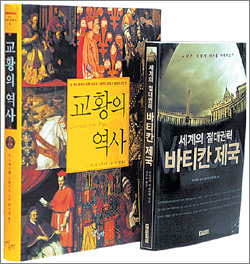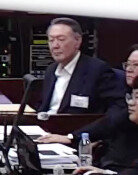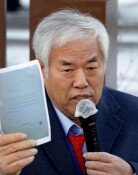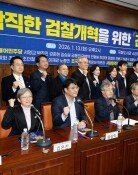The Evolution of the Papacy and the Death of Pope John Paul II
The Evolution of the Papacy and the Death of Pope John Paul II
Posted April. 15, 2005 23:41,

In many ways, the death of Pope John Paul II is being compared with that of former U.S. President Ronald Reagan, who died last June.
The two people were giants, who ruled global politics in the 1980s, miraculously escaped murder attempts against them, and are both hidden heroes in the fall of global communism.
Similarly, the late pontiff and President Reagan also suffered from Parkinsons disease and Alzheimers in their declining years.
However, former President Reagan was a strong leader of the most powerful country in the world, while Pope John Paul II was the head of the smallest country on earth (the Vatican), with a population of about 900 people.
The U.S. president traveled around the world in his presidential aircraft (Air Force One), accompanied by a tremendous amount of reporters, whereas, Pope didnt have his own private plane, and accompanying reporters had to pay their traveling costs.
In addition, the U.S. president possesses military power, which is equipped with a defense budget worth more than those of the North Atlantic Treaty Organization (NATO), Russia, China, Japan, and North Korea, but the Pope has only 110 Swiss guards, at best.
For all that, the death of Pope John Paul II was bigger news than that of former U.S. president Ronald Reagan, which is inexplicable in the context of differences between a religious leader and political leader.
Reading the History of the Popes, a book that details the works of 246 Popes, from Saint Peter to John Paul II, one discovers that it was rare to mourn the Popes death on a large scale.
In the early stages of the Catholic Church, martyrs, who were leaders of a persecuted minority, became Pope, and after the authorization of the Catholic Church by Constantinus the Great, Popes were involved in political struggles and payoff scandals.
Callistus I (who reigned from 217 to 222), was a former convict for swindling and embezzlement, and Vigilio (537 to 555) was stoned to death.
When Celestine Ⅳ (1241) died only 17 days after being narrowly selected as Pope by the Conclave (electors for new Popes) with only 10 Cardinals in two and half months, exposes the ugly desire for power inside the election of Pope.
The Conclave, which proceeded in the middle of a heat wave, reached an agreement only after the death of a cardinal, and another cardinal who was on the verge of death.
Alexandre Ⅵ(1492-1503) is a symbol of a double-faced person, who had at least nine illegitimate children with a number of mistresses.
Leo Ⅹ(1513-1521) is a witness of dissipation, who indiscreetly squandered money by saying that God gave me the gift of being Pope, so lets get wasted, right after his appointment as Pope.
So far, 78 Popes have become saints. One can also know the reason as to why as few as eight Popes were revered as blessed.
Even among the great Popes, only two Popes, including Leo I (440-461), and Gregorio I (590-604), exerted religious spirituality and political leadership at the same time, which eventually led them to be referred to as the greatest Popes.
The fall of Rome in 410, the split between the Western Roman Catholic Church and the Eastern Orthodox Church in 1054, the Protestant Revolution caused by criticism of the sale of indulgences by Martin Luther in 1517, and the reduction in the size of the Papal States to the Vatican City (a size of about Chang-gyeong Palace) in 1870 were all crises that the Catholic Church has faced over the years.
In those endless crises, the reason why the Vatican could exist over the last 2,000 years lies in politics and diplomatic power, which was maintained along with secular power and a not too close, not too far doctrine.
The Pope in Rome was just one of the five bishops of the church, with the others located in Constantinople, Alexandria, Antioch, and Jerusalem until the 6th Century.
However, the Vatican developed the ability to survive from a seesaw game between Rome and Constantinople after the division of Roman Empire, and European emperors appeasement and intimidation, even after the split of the Eastern Orthodox Church, as a form of IQ of the organization.
In particular, the Vatican Empire analyzed how the Vatican garnered more influence than the United Nations (UN) by focusing on the period from the fall of Papal States to the current time.
The foundation of the Vaticans enormous power is not based on financial power or power of information, as is suggested by some conspirators.
Its power lies in nurturing the soft power of being gentle in appearance but hardy in spirit, instead of giving up secular power.
The Popes of the 20th Century have made prudent moves to reform the inside of the Vatican in the face of waves of modernization, such as evolutionary theory, materialism, equality between men and women, and birth control.
Its worthwhile to closely examine the fact that Pope John Ⅱ made Western European political leaders, the secretary general of the U.N., and even an Iranian special envoy fly to the Vatican in order to have an audience with Pope by issuing an opposition statement against the war in Iraq.
Also, the life tenure of Pope, and the collective agreement system of a papal election have advantages over democracy, in which continuous elections elicit concern over the possibility of public popularity dominating policy for short periods of time.
As a result, the Vatican looks to its elites, which supplement any potential failures in leadership, while supporting the display of consistent leadership in the long term.
Original title: Chronicles of the popes (1997)
Welmacht Vatikan (2004)
Chae-Hyun Kwon confetti@donga.com



![[속보]국힘 윤리위, 한동훈 제명 결정…장동혁호 ‘뺄셈 정치’ 가나](https://dimg.donga.com/c/138/175/90/1/wps/NEWS/IMAGE/2026/01/14/133151701.1.jpg)



